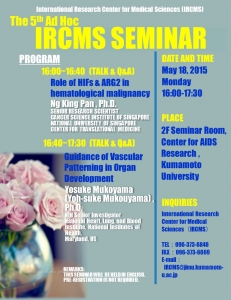Venue: 2F Seminar Room,
Center for AIDS Research, Kumamoto University
Program
16:00~16:40 (Talk and Q&A)
Titile: Role of HIFs & ARG2 in hematological malignancy
Speaker: Ng King Pan, Ph.D. Senior Research Scientist, Cancer Science Institute of Singapore, National University of Singapore
16:40~17:30 (Talk and Q&A)
Title: Guidance of Vascular Patterning in Organ Development
Speaker: Yosuke Mukoyama (Yoh-suke Mukouyama), Ph.D. NIH Senior Investigator, National Heart, Lung, and Blood Institute, National Institutes of Healthe, Maryland, US.
Abstract:
National Heart, Lung, and Blood Institute, National Institutes of Health, Maryland, US
Research in our laboratory is aimed at understanding the cellular and molecular dynamics
that control the elaborate patterns of branching networks in organ development, with a
particular emphasis on two major tubular networks, the vascular and nervous systems.
These systems share several anatomical and structural characteristics, and are often
patterned similarly. Several molecules with attractive and repulsive properties have been
found to modulate the proper guidance of both networks. Here, we focus our studies on
understanding the role of Neuropilin-2 (NRP2) which regulates neuronal axon guidance
as a co-receptor for class 3 Semaphorins (SEMA3s)/PlexinAs signaling and also acts as a
co-receptor for VEGF-C/VEGFR3 signaling in lymphatic vessel development. Among
SEMA3s tested, SEMA3F is preferentially expressed in the epidermis, whereas
SEMA3G expression restricts to dermal arteries. NRP2 is preferentially expressed by
venous and lymphatic vessels. In the lymphatic vascular network formation, SEMA3G
and SEMA3F negatively regulate VEGF-C-mediated lymphatic endothelial cell
proliferation and sprouting through interaction with the NRP2/PlexinA receptor complex.
Given that a mutually exclusive expression of NRP2 (veins) and SEMA3G (arteries) in
the blood vasculature, we also examined whether SEMA3G/NRP2 complex-mediated
signaling influences artery-vein communication in the developing skin. Indeed, loss of
SEMA3G-NRP2 signaling leads to defective artery-vein alignment such that these
mutants exhibit a very close proximity or association between arterial and venous
alignment. Combined, our data suggest that SEMA3/NRP2 signaling functions as an
inhibitory regulator to form intricate vascular and lymphatic network formation.

